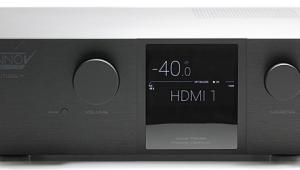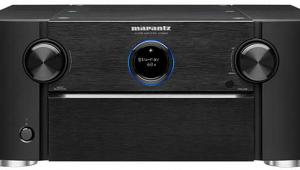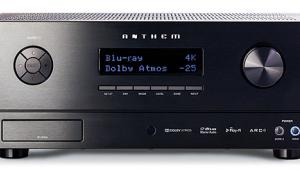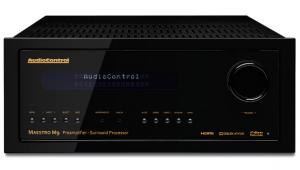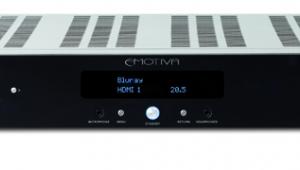I have just a small correction, The remote actually is backlit, It took me a while to figure it out but it is indeed backlit. Look on the side of the remote and you will fine a button>
Marantz AV10 15.4-Channel AV Preamp/Processor Review

AT A GLANCE
Plus
Balanced outputs for all channels
Supports four subwoofers
Audyssey MultEQ XT32 with Directional Bass
Dirac Live Bass Control
Easy on-screen setup
Minus
Antiquated front panel interface
Dirac features cost extra
THE VERDICT
An engineering marvel from
Marantz with just about everything
you could ask for in an AV
processor. Just add an amp and
speakers for total immersion.
The AV processor is the less well-known sibling of the AV receiver. The main difference being that processors don’t have built-in amplification. This is a reasonable approach because as a rule amplifiers last a rather long time, and don’t come obsoleted by things like new immersive sound formats or updates to HDMI standards. Going the AV separate route also lets you tailor the amplification to the speaker system whereas AV receivers are forced to split the difference between whatever speakers are connected to it and hope for the best.
Typically, there’s a significant difference between an AV receiver rated at 100 watts per Channel, and an AV processor that is connected to a home theater amplifier rated at 100 watts per Channel. That difference is the “all channels driven” specification and with an AV receiver you might very well end up with only 30-40 watts per channel when all are driven simultaneously. If you use an AV processor with an amp rated at 100 Watts for all channels driven, you’ll get full power even with the toughest and most demanding audio content.
With the AV10, Marantz has created a new flagship. The review system consisted of the AV10 and AMP10 combo (the AMP10 is a 16-channel amplifier that is the perfect accompaniment to the AV10).
Features
For an overview of the features offered by the AV10, I suggest heading over to the Marantz website. Like cellphones, there’s so much IP inside an AV processor, it is more of a computing device than anything.
The AV10 supports an array of multichannel surround formats, including DTS HD Master, DTS:X, DTS:X Pro, Dolby TrueHD, Dolby Atmos, Auro 3D, and IMAX Enhanced. It offers a maximum of 15.4 processing channels, offering a rich and immersive soundstage. The processor is equipped with Audyssey MultEQ XT32s with optional (paid) Dirac Live upgradability.
The AV10 includes HEOS Multi-room and Streaming, Bluetooth re-transmit for headphones, and compatibility with various voice assistants. For high-resolution audio enthusiasts, the AV10 supports various formats including FLAC, ALAC, WAV, and DSD Audio. It also works as a Roon player, a function I used for practically all of my music listening.
The HDMI specifications include 7 HDMI inputs, 2 main and 1 zone HDMI outputs, and supports 8K/60Hz and 4K/120Hz. Enhanced Audio Return Channel (eARC) and various HDR formats like Dolby Vision and HDR10+ are also supported. Gaming features like ALLM (Auto Low Latency Mode), Variable Refresh Rate, and Quick Frame Transport are included for minimal lag and smoother visuals.
The AV10 has already undergone testing for hardware performance by people like Amir at Audio Science Review and Gene at Audioholics, proving that it has top-notch fidelity. The upshot is that at this performance level what you are really hearing is transparency—the absence of distortion and noise. A peek under the hood reveals meticulous attention to detail.
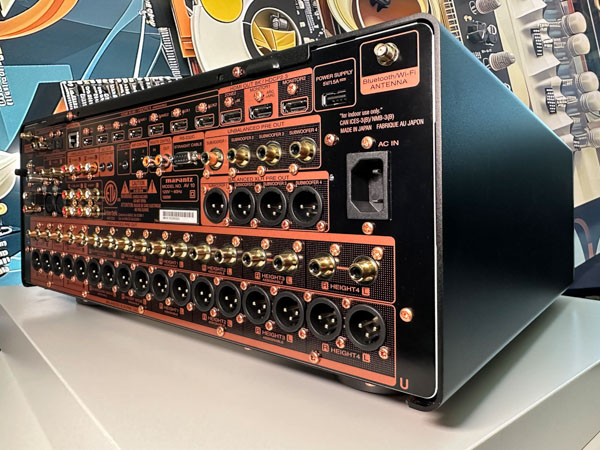
Directional Bass is a newly supported Audyssey feature. I’ve heard it work effectively in demos where you’ll sense the bass energy coming from a general area that correlates to what’s on (or off) screen. I can see situations where, done right, it adds to a sense of total immersion. You can switch between directional and regular bass at will.
This is a three-zone device, so if you don’t use all the channels for a home theater system, you can effectively have it act as three separate audio processors, and with HDMI dual-zone support you can route two separate video sources to the zones of your choice.
Setup
I used the AV10 with three different speaker systems. The first was a 9.4.4 system featuring Arendal Sound 1961 speakers and subs, reviewed in the August/September 2023 issue. The intent being to (almost) max out the processor’s channel count. The second system was a 5.4 Bowers & Wilkins speaker system. This had a pair of 703 S3 towers, a pair of 705 S3 bookshelf speakers, the HTM71 S2 center, and four Bowers & Wilkins DB3D subs—the speakers and subs are also reviewed in this issue. Here the focus is on quality. And the third? A 5.2 system consisting of Pioneer XPRS powered
PA speakers and subs, each connected directly to the AV10 via balanced XLR cables.
I do have one ergonomic complaint, which is that using the front panel and its monochrome display makes it tough to quickly adjust a setting. But with the on-screen display it’s a lot easier to just use the TV. I relied on room correction to set levels and distances.
Performance
Every second I spent listening to the AV10 was a pleasure, and a quick estimate reveals I’ve listened to the AV10 for over two million seconds. It can be difficult to pinpoint what makes a complex surround-sound system sound great but ultimately, it’s the sum of various parts working together effectively.
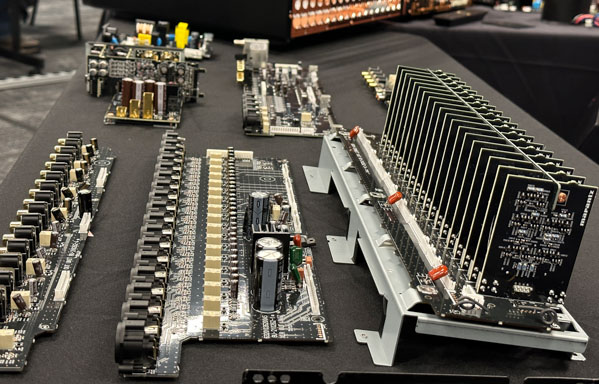
It is no coincidence I was able to tune three totally different speaker systems to a level of performance where they sound transparent and totally at ease with any material. Each time I watched a movie, what came through is how well the speakers are tuned to create proper immer-sion—regardless of how many or what type of speakers I used.
With the Arendal Sound 1961 9.4.4 system, nine of the speakers were tower models, and the entire system is rated at 4 ohms. If you task an AVR with driving all of that, you’ll likely leave up to 6 dB of output on the table compared to robust external amplification. Even without driving all channels simultaneously you’ll start taxing the power supply before the amps themselves reach their output limit. The AMP10 is still power supply-limited, but much less than an AVR. It’s a class D amplifier, so very little of the power it draws from its switch-mode power supply/toroidal transformer combo is wasted and found it a perfect match for the 1961s.
Since the 1961 subs don’t have XLR inputs, I used long RCA cables with no audible noise/hum. They also lack DSP tuning, so I relied entirely on the AV10 to handle bass EQ. The result?
A system that amazed with its cohesiveness. I certainly credit the AV10 with making it all work. Without needing to deep dive into its many settings, the standard Audyssey routines and then manually choosing 80 Hz for a crossover to the subs worked out great. With the subs running in sealed mode, I saw measured extension right down to 10 Hz.
The Bowers & Wilkins 5.4-system, despite the much lower speaker and channel count, is the best-sounding rig I’ve reviewed in the past year and one of the top systems ever. Here, with only five speakers to power, the option exists to bridge the channels on the AMP10, or to biamp all five speakers. But it hardly matters how you wire it up unless you like pushing gear to its limits. I like gear I never need to max out; with only five speakers to power, the AMP10 had an easy time of it.
The combo of Bowers & Wilkins and Marantz is under the same corporate umbrella, Sound United. And based on aesthetics and price points, you can hardly find a better match for the Marantz system than the 700 S3 series speakers. I found the sense of immersion, from simple 5.1 audio, was still incredibly enveloping. How? Because the entire system delivered true high-fidelity audio; the entire soundfield was effectively holographic. The only thing missing was explicit over-head effects, which can always be added with more speakers, and I can only imagine what could be achieved if you maxed out the AV10’s channel count with 700 S3 speakers. Still, movie after movie sounded seamless, never any issues with dialog clarity.
The four DB3D subs in the Bowers & Wilkins system were situated in the same spots that I put the Arendal Sound 1961 subwoofers—basically two up front and two behind the seating area. The correction curve Audyssey chose is nearly identical for the Bowers & Wilkins and for the Arendal Sound subwoofers. It indicates the room correction system truly is just correcting for the room (and succeeding).
The Bowers & Wilkins plus Marantz AV10/AMP10 system showed the value of spending on quality over quality. I did not expect the overall effect to be more aurally appealing than the Arendal Sound system, but many times I simply liked it better. As subjective a judgment as that is, it is how I feel.
And then there’s the Pioneer PA system. No need for the AMP10, and they lean heavily on room correction and EQ to play nice in a home theater. This is not new territory for me, years ago on AVS Forum I started a thread about using Behringer B215XLs as home theater speakers. It was a popular choice for those who accept letting room correction fix the response curve. The result, you get amazing output and dynamics for comparatively little dough versus “home” speakers.
These Pioneer speakers are a lot nicer and more capable than those Behringers. And they accept a balanced XLR signal, so they work optimally with the AV10. And guess what? Holy crap! I’m listening to it as I type this. They are crisp, clear, smooth and dynamic. They image well and retain a proper soundstage when sitting off center. But there is one catch, the PA subs Pioneer shipped with them are big and loud but don’t play all that deep. So, I left the four Bowers & Wilkins DB3D subs hooked up and used them with the Pioneers. While an effing expletive does the most justice to how awesome that combo worked out, what I will spell out is that it throbs and shakes and gets guttural while also dicing and slicing like an Iron Chef. It sounds like a nightclub!
With powered PA speakers, the entire system is free to play to its maximum potential. Pioneer claims 131 dB peak output. That’s irrelevant to me aside from describing how much headroom there is: tons.
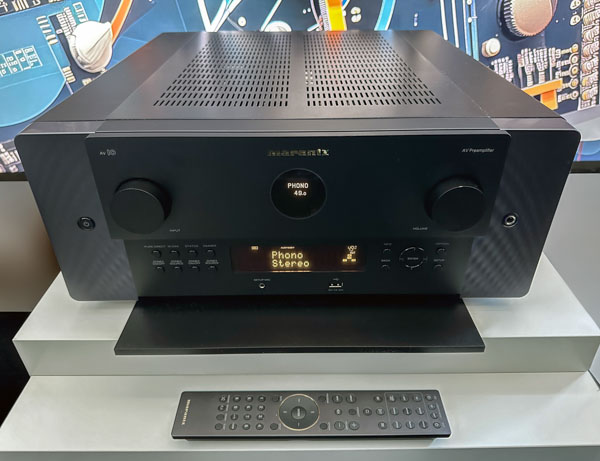
So, the cat is out of the bag. I will be reviewing the full Pioneer system in an upcoming issue. But I do want to touch on what happens if you use the Pioneer subs instead of the Bowers & Wilkins subs. This is a 5.2 system with three XPRS 122 speakers (L/C/R) and two XPRS 102 speakers as surrounds. The subs are the XPRS 1152S, a 15-inch ported sub designed for live music/PA duty so, its spec only goes down to 45 Hz (-6 dB) but promises up to 129 dB SPL output (to roughly match the speakers).
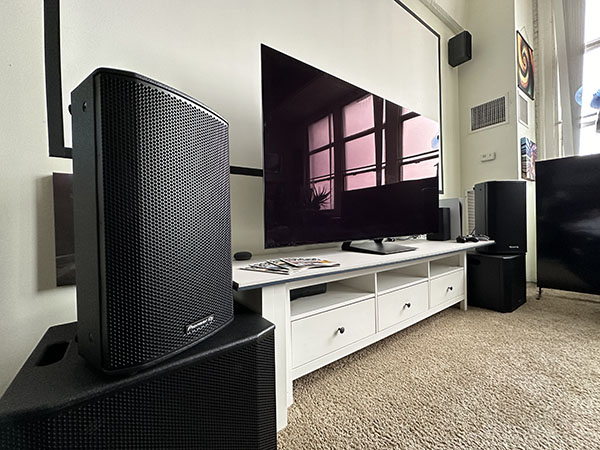
What happens if you let the AV10 tune the Pioneer sub system? I let Audyssey have a go at it. You get nicely tuned sound, with proper EQ and very powerful bass. But not bloated at all, the sub’s sound is totally transformed! They play flat, right down to 45 Hz as the specs state. At which point the sub literally cuts everything off! Oh well. It’s a brick wall, you get nothing below 45 Hz. Such is the engineering “cost” of building a high-output sub that does not self-destruct. So what benefit is there? Well, let’s just say there’s a ton of output in the range that live music uses. Get it? Live music, just like what these speakers were designed to play.
45 Hz extension is no good for home theater, but dang I can get into a ton of trouble playing hip-hop and reggae dub classics through this rig. It slams, whether it’s Black Uhuru’s Dub Experience or Mobb Deep’s The Infamous. For something more modern in production, yet classic in sound, a thorough and deep listening to Metallic Spheres in Colour by The Orb and David Gilmour was as trippy and absorbing and inter-esting as with any other speaker system I have tried. It just emphasizes different qualities versus the other speakers, it’s more direct and able to cleanly achieve output levels the other speaker systems could not touch. Also, the Pioneer subs make nice stands for the speakers!
So, the AV10 can tame even an unruly active PA speaker system, making it into a credible system for music, or blending them with home theater subs. And it can make top-tier speakers strut their stuff, so much so it can coax a 5.1-channel Bowers & Wilkins system into outperforming the already great Arendal Sound 9.4.4 1961 system. This ability to sort through the issues and deliver the best each system has to offer is a sign of a great processor, one that has a good chance of properly handling whatever an owner might throw at it.
If the purpose of a performance section is to find limitations and describe them, I’d be stuck complaining that the remote control. Nice as it is that the faceplate is a piece of metal, it still uses IR instead of Bluetooth, and has tiny buttons that are hard to read.
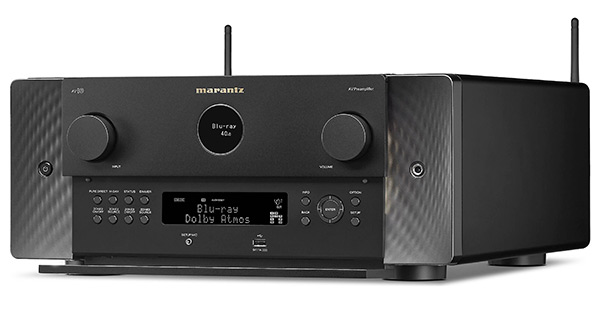
Do you see where I am going with this? The AV10 is beyond what I need, but also is also everything I desire in an AV processor. Sure, I know there’s Trinnov and StormAudio out there, promising even more channels and even more sophisticated room correction. But that’s the thing, with the AV10 I’m already done, with overkill. I don’t see jumping from a four-figure MSRP into the world of five-figure price tag processors gaining me anything, I’d rather put the money into speakers and subs because the AV10 is already an endgame AV processor.
Conclusion
One word says it all: superlative. The AV10 is a dream machine. That’s the main thing you need to know. And unless you are doing a billionaire-level home theater, it can probably handle whatever it is you need it to do, just like how for me, it handled three dramatically different speaker systems and made each of them into a compelling, cohesive listening experience. It proved its capability and adaptability in real life.
If you are willing and able to invest in separate amplification, the AV10 is at once incredibly powerful yet surprisingly accessible. It is a consumer product, but one with professional capability that can take your home theater or living room system to new heights of audio fidelity and AV content playback.
Specs
MULTICHANNEL SURROUND SUPPORT: DTS HD Master, DTS:X, DTS:X Pro, Dolby TrueHD, Dolby Atmos, Auro 3D, IMAX Enhanced
PROCESSING CHANNELS: 15.4
NETWORK CAPABILITIES: HEOS Multi-room and streaming, Bluetooth re-transmit for headphones, compatibility with various voice assistants
STREAMING SERVICES: Support for Spotify, Pandora, SiriusXM, Amazon Music HD, TIDAL, and more
HDMI SPECIFICATIONS: 7 HDMI inputs, 2 main and 1 zone HDMI outputs, 8K/60Hz and 4K/120Hz support, Enhanced ARC, and various HDR formats including Dolby Vision and HDR10+
GAMING FEATURES: ALLM, Variable Refresh Rate, Quick Frame Transport
CONTROL AND INTEGRATION: IP, RS232, Web, and App Control, IR Flasher In, Marantz Remote Bus
AUDIO FORMATS: Gapless playback for FLAC, WAV, ALAC, DSD, and support for lossy formats like MP3, WMA, AAC, Phono Input
- Log in or register to post comments


Greetings, friends! Today I came across a great casino called mr.bet Casino in Australia - a real find for gambling enthusiasts! With over 1,500 games from top providers like NetEnt and Microgaming, there's something for everyone. I'm particularly fond of their slots - the variety of themes and high-quality graphics always keep me enthralled. I recommend you to check them out!

Thank you for sharing such a useful article, defiantly i will share to my friends and WhatsApp groups -

A Digital Marketing Agency in Gurgaon offers comprehensive online marketing services, including SEO, PPC, social media marketing, content creation, and web development. These agencies specialize in driving brand visibility, generating leads, and boosting ROI for businesses in diverse industries.


